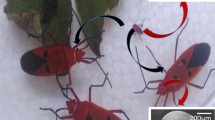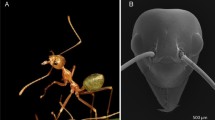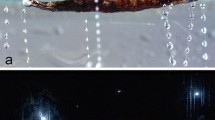Summary
The gravid females of Mermis are positively phototaxic at the time of their migration to egglaying sites in vegetation on which their grasshopper hosts feed. On a horizontal felt surface, segments of the path traced by the tail are oriented approximately towards a source of monochromatic light in the 350–540 nm region, but are not oriented at longer wavelengths and in the dark. The components of this phototaxis include locomotion by the posterior 4/5 of the body, orientational bending of the neck region while the anterior is held above the substrate, and a scanning motion (bending) of the head region (anterior 2 mm). Like other nematodes and snakes, propulsion is associated with posteriorly propagated body waves, but unlike other animals known, the waves tend to lie perpendicular to a felt surface, and unlike other nematodes, contact with the surface is on the female's ventral surface. The body waves are initiated by the motion of the anterior 1/5 (15 mm) of the body, the average orientation of which determines the path of the following 4/5.
During phototaxis, the anterior tip is swung both sideways and vertically about the direction towards the light source. The tip motion is a result of a scanning motion of the head and a slower orientational bending of the neck. The base of the head appears to be actively directed towards the source by the bending of the neck. This behavior can resolve two light sources positioned 120° apart but not 90° apart. The scanning motion of the head is independent of neck orientation and appears to enhance the probability of discovering the direction of a new source. Discovery is followed by a directed turn of the base of the head towards the source which is initiated by the bending of the neck. Locomotion of the body follows the path of the anterior through the turn and phototaxis is thus initiated.
Similar content being viewed by others
References
Bolwig N (1946) Senses and sense organs of the anterior end of the house fly larvae. Dansk Naturhistorisk Forening Videnskabelige Meddelelser 109:80–212
Burr AH (1979) Analysis of phototaxis in nematodes using directional statistics. J Comp Physiol 134:85–93
Burr AH (1984) Photomovement behavior in simple invertebrates. In: Ali MA (ed) Photoreception and vision in invertebrates. Plenum Press, pp 179–215
Burr AH (1985) The photomovement of Caenorhabditis elegans, a nematode which lacks ocelli. Proof that the response is to light not radiant heating. Photochem Photobiol 41:577–582
Burr AHJ, Babinszki CPF (1990) Scanning motion, ocellar morphology and orientation mechanisms in the phototaxis of the nematode Mermis nigrescens. J Comp Physiol A 167:257–268
Burr AH, Burr C (1975) The amphid of the nematode Oncholaimus vesicarius: Ultrastructural evidence for a dual function as chemoreceptor and photoreceptor. J Ultrastruct Res 51:1–15
Burr AHJ, Eggleton DK, Patterson R, Leutscher-Hazelhoff JT (1989) The role of hemoglobin in the phototaxis of the nematode Mermis nigrescens. Photochem Photobiol 49:89–95
Chalfie M, Sulston JE, White JG, Southgate E, Thomson JN, Brenner S (1985) The neural circuit for touch sensitivity in C. elegans. J Neurosci 5:956–964
Chalfie M, White JG (1988) The nervous system. Chap. 11 in The nematode Caenorhabditis elegans. WB Wood, ed. Cold Spring Harbor Laboratory
Cobb NA (1929) The chromatropism of Mermis subnigrescens, a nemic parasite of grasshoppers. J Wash Acad Sci 19:159–166
Croll NA (1966) A contribution to the light sensitivity of the “chromatrope” of Mermis subnigrescens. J Helminthol 40:33–38
Foster KW, Smyth RD (1980) Light antennas in phototactic algae. Microbiol Rev 44:572–630
Fraenkel GS, Gunn DL (1961) The orientation of animals. Dover, New York
Gans C (1974) Biomechanics, An approach to vertebrate biology. JB Lippincott Company, Philadelphia
Gray J, Lissmann HW (1964) The locomotion of nematodes. J Exp Biol 41:135–54
Green CD (1971) Mating and host finding behavior of plant nematodes. Plant Parasitic Nematodes 2:247–266
Hader D-P, Melkonian M (1983) Phototaxis in the gliding flagellate, Euglena mutabilis. Arch Microbiol 135:25–29
Hader D-P, Lebert M, DiLena MR (1987) New evidence for the mechanism of phototactic orientation of Euglena gracilis. Curr Microbiol 14:157–163
Hedgcock EM, Russell RL (1975) Normal and mutant thermotaxis in the nematode Caenorhabditis elegans. Genetics 72:4061–4065
Jennings HS (1906) Behavior of the lower organisms. Indiana Univ Press, Bloomington (1976 reprint)
Johnson CD, Stretton AOW (1985) Localization of choline acetyltransferase within identified motoneurons of the nematode Ascaris. J Neurosci 5:1984–1992
Johnson CD, Stretton AOW (1987) GABA-immunoreactivity in inhibitory motor neurons of the nematode Ascaris. J Neurosci 7:223–235
Mast SO (1911) Light and the behavior of organisms. Wiley, New York
Nultsch W, Hader D-P (1988) Photomovement in motile microorganisms — II. Photochem Photobiol 47:837–869
Stretton AOW, Davis RE, Angstadt JD, Donmoyer JE, Johnson CD (1985) Neural control of behavior in Ascaris. Trends Neurosci 8:294–300
Wallace HR (1959) Movement of eelworms in water films. Ann Appl Biol 47:366–370
Ward S (1973) Chemotaxis by the nematode Caenorhabditis elegans: Identification of attractants and analysis of the response by use of mutants. Proc Natl Acad Sci USA 70:817–821
Ward S, Thomson JN, White JG, Brenner S (1975) Electron microscopical reconstruction of the anterior sensory anatomy of the nematode Caenorhabditis elegans. J Comp Neurol 160:313–337
White JG, Southgate E, Thomson JN, Brenner S (1976) The structure of the ventral nerve cord of Caenorhabditis elegans. Philos Trans R Soc Lond B 275:327–348
White JG, Southgate E, Thomson JN, Brenner S (1986) The structure of the nervous system of Caenorhabditis elegans. Philos Trans R Soc Lond B 314:1–340
Author information
Authors and Affiliations
Rights and permissions
About this article
Cite this article
Burr, A.H.J., Babinszki, C.P.F. & Ward, A.J. Components of phototaxis of the nematode Mermis nigrescens . J Comp Physiol A 167, 245–255 (1990). https://doi.org/10.1007/BF00188117
Accepted:
Issue Date:
DOI: https://doi.org/10.1007/BF00188117




